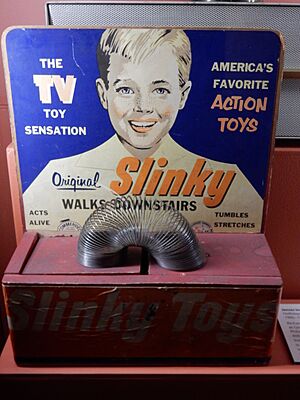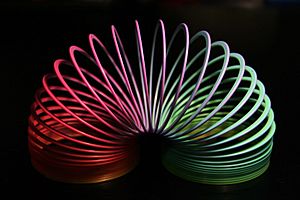Slinky facts for kids

A Slinky made out of metal
|
|
| Type | Spring toy |
|---|---|
| Inventor(s) |
|
| Company | James Industries |
| Country | United States |
| Availability | 1945–present |
The Slinky is a fun toy made from a special spring. It was invented by an American engineer named Richard T. James in 1943. The Slinky was first shown to the public at a department store in Philadelphia on November 27, 1945.
This amazing toy can do many cool tricks. It can "walk" down stairs by stretching and reforming itself. Gravity helps it move, along with its own momentum. It can also seem to float in the air for a moment when it's dropped. These interesting features have made the Slinky very popular in the United States. It has also inspired many other toys around the world that use similar spring parts.
Contents
The Slinky's Journey: How It Began
Inventing the Slinky Toy
In 1943, Richard T. James, a naval engineer, saw a spring fall from a shelf. He noticed it "stepped" down and then landed upright. Richard's wife, Betty, remembered him saying, "I think if I got the right kind of steel, I could make it walk."
Richard spent the next year trying different types of steel wire. Finally, he found a spring that would "walk." Betty was not sure at first. But she changed her mind when the toy was perfected. The children in their neighborhood loved it right away!

Richard and Betty started their own company, James Industries. They began making Slinkys in Clifton Heights, Pennsylvania. Each Slinky sold for $1. They were about 2.5 inches (6.4 cm) tall. Each one had 98 coils of high-quality Swedish steel.
At first, it was hard to sell the Slinky to toy stores. But in 1945, they got permission to show it at Gimbels Department Store in Philadelphia. They set up a ramp to demonstrate how it worked. It was a huge success! The first 400 Slinkys sold out in just 90 minutes. In 1946, the Slinky was shown at the American International Toy Fair.
Even though the Slinky started at $1, its price sometimes went up. This was because the cost of steel increased. However, Betty James always wanted the Slinky to be affordable for everyone. So, it has stayed a reasonably priced toy throughout its history.
Besides being a toy, the Slinky has been used in classrooms to teach science. It was also used as a portable radio antenna by soldiers, especially during the Vietnam War. The Slinky was added to the National Toy Hall of Fame in 2000. In 2003, it was named one of the most memorable toys of the 20th century. In its first 60 years, about 300 million Slinkys were sold!
Changes Over Time
In 1960, Richard James left the company. He became a missionary in Bolivia. Betty James then moved the company to Hollidaysburg, Pennsylvania in 1964. The company grew a lot under her leadership. She believed the toy's success came from its "simplicity."
James Industries was sold to Poof Products, Inc. in 1998. Slinky toys continued to be made in Hollidaysburg. Betty James passed away in November 2008 at the age of 90. She had been the president of James Industries from 1960 to 1998.
In July 2012, Poof-Slinky, Inc. was bought by a company called Propel Equity Partners. By 2014, Propel Equity Partners combined Poof-Slinky with other toy brands to create Alex Brands. In July 2020, the Slinky brand was sold again, this time to Just Play.
How the Slinky Works
The way a Slinky moves is based on basic physics laws. These include Hooke's law, which describes how springs stretch, and gravitation, which is the force of gravity.
Slinky in Motion
When a Slinky is placed on stairs, it moves energy along its coils. It creates a wave-like motion. The whole spring goes down step by step, end over end. It looks like it's "walking" down the stairs.
If you hold a Slinky by the top and let go, the top part starts to fall. But the bottom part stays in place for a moment. This is because the change in tension needs to travel down the spring. The spring then compresses as it falls. This creates a short moment where the bottom seems to hang still. For an original Slinky, this "hang time" is about 0.3 seconds.
Slinky's Commercial Success
The Famous Slinky Jingle
The catchy song for the Slinky television commercial was made in 1962. Johnny McCullough and Homer Fesperman wrote the music. Charles Weagly wrote the words. This jingle became one of the longest-running advertising songs ever!
The Slinky jingle has been used and joked about in many TV shows and movies. You can hear it in the "Log" commercial on The Ren & Stimpy Show. Actor Jim Carrey sings it in Ace Ventura: When Nature Calls. It's also sung in the movie Lords of Dogtown and by Eddie Murphy in his stand-up comedy film Eddie Murphy Raw.
Slinky Dog Toy
Early in the history of James Industries, a woman named Helen Herrick Malsed sent them an idea. She sent drawings for Slinky pull-toys. The company liked her ideas. So, the Slinky Dog and Slinky Train were added to their products.
The Slinky Dog first appeared in 1952. It was a small plastic dog with its front and back parts joined by a metal Slinky. Helen Malsed received a lot of money from her patent for the Slinky pull-toy idea for 17 years.
In 1995, the Slinky Dog was redesigned for the Toy Story movies by Pixar. The original Slinky Dog had been stopped a few years before. Betty James liked the new Slinky Dog. She told the news, "The earlier Slinky Dog wasn't nearly as cute as this one."
Plastic Slinky Toys
Plastic Slinkys are also available and come in many colors. Many are made with the colors of the rainbow. They became popular in the 1970s. People thought they were safer than metal Slinkys. This was because they didn't cause a problem if put into electrical outlets.
The plastic spring toy was invented by Donald James Reum. He worked at Master Mark Plastics in Albany, Minnesota. Reum got the idea while trying to make a spiral hose for watering plants. But when it came off the machine, his children said it looked more like a "Slinky." He kept working on it until it was perfect. Then he showed his idea to Betty James. Reum made the Plastic Slinky for Betty James for several years. Later, James Industries decided to make the plastic Slinky themselves.
Awards and Special Recognitions
In 1999, the United States Postal Service made a Slinky postage stamp. The Slinky was added to the National Toy Hall of Fame in 2000. A bill was even proposed in 2001 to make the Slinky the official state toy of Pennsylvania, but it didn't pass. In the same year, Betty James was honored in the Toy Industry Association's Hall of Fame. In 2003, the Slinky was named one of the 100 most memorable and creative toys of the 20th century.
Other Ways to Use a Slinky
Slinkys can be used to make a "laser gun" sound effect. You hold a metal Slinky in the air and tap one end. It makes a metallic sound that quickly drops in pitch. You can make the sound louder by attaching a plastic cup to one end.
The Helixophone is a musical instrument created by artist Sonia Paço-Rocchia. It is made with a Slinky and a special sound box. Hélix is a sound art project that uses up to 20 Helixophones. They are automated and play an interactive sound composition.
Metal Slinkys can also be used as a radio antenna. They work well for radio signals between 7 and 8 MHz. During the Vietnam War, soldiers used them as portable antennas for talking to each other nearby. They were small, easy to set up, and worked well. They also helped extend the range of handheld radios.
In 1985, astronauts on the Space Shuttle Discovery made a video. They showed how familiar toys behaved in space. One astronaut said the Slinky "sort of droop[ed]" in space. This video was made to get school children interested in physics and how things act in weightlessness.
Many online videos show that a Slinky can be put on a bird feeder pole. This helps stop squirrels from climbing up and eating the bird food!
See also
 In Spanish: Slinky para niños
In Spanish: Slinky para niños


